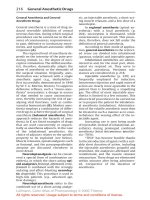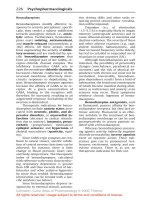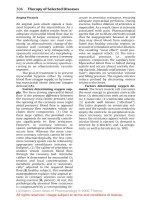Color Atlas of Pharmacology (Part 17): Drugs Acting on Motor Systems
Bạn đang xem bản rút gọn của tài liệu. Xem và tải ngay bản đầy đủ của tài liệu tại đây (453.63 KB, 12 trang )
Drugs Affecting Motor Function
The smallest structural unit of skeletal
musculature is the striated muscle fiber.
It contracts in response to an impulse of
its motor nerve. In executing motor pro-
grams, the brain sends impulses to the
spinal cord. These converge on !-moto-
neurons in the anterior horn of the spi-
nal medulla. Efferent axons course, bun-
dled in motor nerves, to skeletal mus-
cles. Simple reflex contractions to sen-
sory stimuli, conveyed via the dorsal
roots to the motoneurons, occur with-
out participation of the brain. Neural
circuits that propagate afferent impuls-
es into the spinal cord contain inhibit-
ory interneurons. These serve to pre-
vent a possible overexcitation of moto-
neurons (or excessive muscle contrac-
tions) due to the constant barrage of
sensory stimuli.
Neuromuscular transmission (B) of
motor nerve impulses to the striated
muscle fiber takes place at the motor
endplate. The nerve impulse liberates
acetylcholine (ACh) from the axon ter-
minal. ACh binds to nicotinic cholinocep-
tors at the motor endplate. Activation of
these receptors causes depolarization of
the endplate, from which a propagated
action potential (AP) is elicited in the
surrounding sarcolemma. The AP trig-
gers a release of Ca
2+
from its storage or-
ganelles, the sarcoplasmic reticulum
(SR), within the muscle fiber; the rise in
Ca
2+
concentration induces a contrac-
tion of the myofilaments (electrome-
chanical coupling). Meanwhile, ACh is
hydrolyzed by acetylcholinesterase
(p. 100); excitation of the endplate sub-
sides. If no AP follows, Ca
2+
is taken up
again by the SR and the myofilaments
relax.
Clinically important drugs (with
the exception of dantrolene) all inter-
fere with neural control of the muscle
cell (A, B, p. 183 ff.)
Centrally acting muscle relaxants
(A) lower muscle tone by augmenting
the activity of intraspinal inhibitory
interneurons. They are used in the treat-
ment of painful muscle spasms, e.g., in
spinal disorders. Benzodiazepines en-
hance the effectiveness of the inhibitory
transmitter GABA (p. 226) at GABA
A
re-
ceptors. Baclofen stimulates GABA
B
re-
ceptors. !
2
-Adrenoceptor agonists such
as clonidine and tizanidine probably act
presynaptically to inhibit release of ex-
citatory amino acid transmitters.
The convulsant toxins, tetanus tox-
in (cause of wound tetanus) and strych-
nine diminish the efficacy of interneu-
ronal synaptic inhibition mediated by
the amino acid glycine (A). As a conse-
quence of an unrestrained spread of
nerve impulses in the spinal cord, motor
convulsions develop. The involvement
of respiratory muscle groups endangers
life.
Botulinum toxin from Clostridium
botulinum is the most potent poison
known. The lethal dose in an adult is ap-
prox. 3 ҂ 10
–6
mg. The toxin blocks exo-
cytosis of ACh in motor (and also para-
sympathetic) nerve endings. Death is
caused by paralysis of respiratory mus-
cles. Injected intramuscularly at minus-
cule dosage, botulinum toxin type A is
used to treat blepharospasm, strabis-
mus, achalasia of the lower esophageal
sphincter, and spastic aphonia.
A pathological rise in serum Mg
2+
levels also causes inhibition of ACh re-
lease, hence inhibition of neuromuscu-
lar transmission.
Dantrolene interferes with electro-
mechanical coupling in the muscle cell
by inhibiting Ca
2+
release from the SR. It
is used to treat painful muscle spasms
attending spinal diseases and skeletal
muscle disorders involving excessive
release of Ca
2+
(malignant hyperther-
mia).
182 Drugs Acting on Motor Systems
Lüllmann, Color Atlas of Pharmacology © 2000 Thieme
All rights reserved. Usage subject to terms and conditions of license.
Drugs Acting on Motor Systems 183
Depola-
rization
Attenuated
inhibition
Inhibitory
interneuron
Tetanus
Toxin
Inhibition
of release
Glycine
Strychnine
Receptor
antagonist
ConvulsantsMyotonolytics
Increased
inhibition
Inhibitory
neuron
Benzodiazepines
e.g., diazepam
GABA
Agonist
Baclofen
(GABA =
"-aminobutyric acid)
B. Inhibition of neuromuscular transmission and electromechanical coupling
A. Mechanisms for influencing skeletal muscle tone
Antiepileptics Antiparkinsonian drugs
Myotonolytics Dantrolene
Muscle relaxants
Mg
2+
Botulinum toxin
inhibit
ACh-release
Muscle relaxants
inhibit generation
of action
potential
Sarcoplasmic
reticulum
Action potential
Motor
neuron
Motor
endplate
ACh receptor
(nicotinic)
Myofilaments
Contraction
Ca
2+
Membrane potential
Muscle tone
ms 10 20
ACh
t-Tubule
Dantrolene
inhibits
Ca
2+
release
Lüllmann, Color Atlas of Pharmacology © 2000 Thieme
All rights reserved. Usage subject to terms and conditions of license.
Muscle Relaxants
Muscle relaxants cause a flaccid paraly-
sis of skeletal musculature by binding to
motor endplate cholinoceptors, thus
blocking neuromuscular transmission (p.
182). According to whether receptor oc-
cupancy leads to a blockade or an exci-
tation of the endplate, one distinguishes
nondepolarizing from depolarizing
muscle relaxants (p. 186). As adjuncts to
general anesthetics, muscle relaxants
help to ensure that surgical procedures
are not disturbed by muscle contrac-
tions of the patient (p. 216).
Nondepolarizing muscle relaxants
Curare is the term for plant-derived ar-
row poisons of South American natives.
When struck by a curare-tipped arrow,
an animal suffers paralysis of skeletal
musculature within a short time after
the poison spreads through the body;
death follows because respiratory mus-
cles fail (respiratory paralysis). Killed
game can be eaten without risk because
absorption of the poison from the gas-
trointestinal tract is virtually nil. The cu-
rare ingredient of greatest medicinal
importance is d-tubocurarine. This
compound contains a quaternary nitro-
gen atom (N) and, at the opposite end of
the molecule, a tertiary N that is proto-
nated at physiological pH. These two
positively charged N atoms are common
to all other muscle relaxants. The fixed
positive charge of the quaternary N ac-
counts for the poor enteral absorbabil-
ity.
d-Tubocurarine is given by i.v. in-
jection (average dose approx. 10 mg). It
binds to the endplate nicotinic cholino-
ceptors without exciting them, acting as
a competitive antagonist towards ACh.
By preventing the binding of released
ACh, it blocks neuromuscular transmis-
sion. Muscular paralysis develops with-
in about 4 min. d-Tubocurarine does not
penetrate into the CNS. The patient
would thus experience motor paralysis
and inability to breathe, while remain-
ing fully conscious but incapable of ex-
pressing anything. For this reason, care
must be taken to eliminate conscious-
ness by administration of an appropri-
ate drug (general anesthesia) before us-
ing a muscle relaxant. The effect of a sin-
gle dose lasts about 30 min.
The duration of the effect of d-tubo-
curarine can be shortened by adminis-
tering an acetylcholinesterase inhibitor,
such as neostigmine (p. 102). Inhibition
of ACh breakdown causes the concen-
tration of ACh released at the endplate
to rise. Competitive “displacement” by
ACh of d-tubocurarine from the recep-
tor allows transmission to be restored.
Unwanted effects produced by d-tu-
bocurarine result from a nonimmune-
mediated release of histamine from
mast cells, leading to bronchospasm, ur-
ticaria, and hypotension. More com-
monly, a fall in blood pressure can be at-
tributed to ganglionic blockade by d-tu-
bocurarine.
Pancuronium is a synthetic com-
pound now frequently used and not
likely to cause histamine release or gan-
glionic blockade. It is approx. 5-fold
more potent than d-tubocurarine, with
a somewhat longer duration of action.
Increased heart rate and blood pressure
are attributed to blockade of cardiac M
2
-
cholinoceptors, an effect not shared by
newer pancuronium congeners such as
vecuronium and pipecuronium.
Other nondepolarizing muscle re-
laxants include: alcuronium, derived
from the alkaloid toxiferin; rocuroni-
um, gallamine, mivacurium, and atra-
curium. The latter undergoes spontane-
ous cleavage and does not depend on
hepatic or renal elimination.
184 Drugs Acting on Motor Systems
Lüllmann, Color Atlas of Pharmacology © 2000 Thieme
All rights reserved. Usage subject to terms and conditions of license.
Drugs Acting on Motor Systems 185
ACh
A. Non-depolarizing muscle relaxants
Arrow poison of indigenous South Americans
Blockade of ACh receptors
No depolarization of
endplate
Relaxation of skeletal muscles
(Respiratory paralysis)
Artificial
ventilation
necessary
(plus general
anesthesia!)
Antidote:
cholinesterase
inhibitors
e.g., neostigmine
(no enteral absorption)
d-Tubocurarine Pancuronium
Lüllmann, Color Atlas of Pharmacology © 2000 Thieme
All rights reserved. Usage subject to terms and conditions of license.
Depolarizing Muscle Relaxants
In this drug class, only succinylcholine
(succinyldicholine, suxamethonium, A)
is of clinical importance. Structurally, it
can be described as a double ACh mole-
cule. Like ACh, succinylcholine acts as
agonist at endplate nicotinic cholino-
ceptors, yet it produces muscle relaxa-
tion. Unlike ACh, it is not hydrolyzed by
acetylcholinesterase. However, it is a
substrate of nonspecific plasma cholin-
esterase (serum cholinesterase, p. 100).
Succinylcholine is degraded more slow-
ly than is ACh and therefore remains in
the synaptic cleft for several minutes,
causing an endplate depolarization of
corresponding duration. This depola-
rization initially triggers a propagated
action potential (AP) in the surrounding
muscle cell membrane, leading to con-
traction of the muscle fiber. After its i.v.
injection, fine muscle twitches (fascicu-
lations) can be observed. A new AP can
be elicited near the endplate only if the
membrane has been allowed to repo-
larize.
The AP is due to opening of voltage-
gated Na-channel proteins, allowing
Na
+
ions to flow through the sarcolem-
ma and to cause depolarization. After a
few milliseconds, the Na channels close
automatically (“inactivation”), the
membrane potential returns to resting
levels, and the AP is terminated. As long
as the membrane potential remains in-
completely repolarized, renewed open-
ing of Na channels, hence a new AP, is
impossible. In the case of released ACh,
rapid breakdown by ACh esterase al-
lows repolarization of the endplate and
hence a return of Na channel excitabil-
ity in the adjacent sarcolemma. With
succinylcholine, however, there is a per-
sistent depolarization of the endplate
and adjoining membrane regions. Be-
cause the Na channels remain inactivat-
ed, an AP cannot be triggered in the ad-
jacent membrane.
Because most skeletal muscle fibers
are innervated only by a single endplate,
activation of such fibers, with lengths
up to 30 cm, entails propagation of the
AP through the entire cell. If the AP fails,
the muscle fiber remains in a relaxed
state.
The effect of a standard dose of suc-
cinylcholine lasts only about 10 min. It
is often given at the start of anesthesia
to facilitate intubation of the patient. As
expected, cholinesterase inhibitors are
unable to counteract the effect of succi-
nylcholine. In the few patients with a
genetic deficiency in pseudocholineste-
rase (= nonspecific cholinesterase), the
succinylcholine effect is significantly
prolonged.
Since persistent depolarization of
endplates is associated with an efflux of
K
+
ions, hyperkalemia can result (risk of
cardiac arrhythmias).
Only in a few muscle types (e.g.,
extraocular muscle) are muscle fibers
supplied with multiple endplates. Here
succinylcholine causes depolarization
distributed over the entire fiber, which
responds with a contracture. Intraocular
pressure rises, which must be taken into
account during eye surgery.
In skeletal muscle fibers whose mo-
tor nerve has been severed, ACh recep-
tors spread in a few days over the entire
cell membrane. In this case, succinyl-
choline would evoke a persistent depo-
larization with contracture and hyper-
kalemia. These effects are likely to occur
in polytraumatized patients undergoing
follow-up surgery.
186 Drugs Acting on Motor Systems
Lüllmann, Color Atlas of Pharmacology © 2000 Thieme
All rights reserved. Usage subject to terms and conditions of license.









